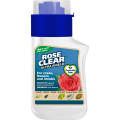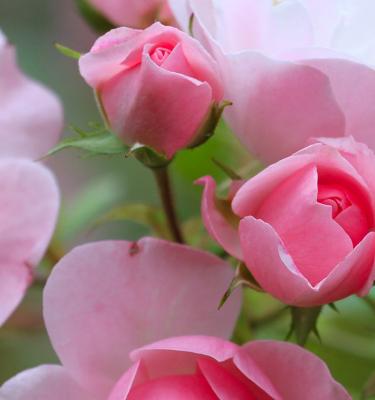

How to plant and care for roses
Roses (Rosa) are among the UK’s favourite garden plants – they conjure up long hot summer days and romantic cottage gardens. They can climb and clothe a bare wall or ugly fence and provide your garden with gorgeous colour and fragrance all summer long. Read our growing guide below to find out all you need to help you choose the type you want as well as tips on how to grow and look after them.
Growing roses - what you’ll need and how to grow them
It’s always a good idea to make sure you have the right place to plant a rose. There are many types and varieties to choose from and some will prefer slightly different conditions than others but on the whole roses prefer good light, with lots of sunshine shelter from winds, space between plants to allow for air flow and really good, rich improved soil or compost if growing in containers.
Roses root deeply and are hungry feeders, so make sure the soil has plenty of organic matter forked in and is mulched and be prepared to feed your roses, ideally with a continuous release fertiliser. All soils can benefit from this but especially light, sandy soils that tend to dry out quickly as well as leaching nutrients.
Most roses prefer a neutral soil so if you have either extreme alkaline or acid soil then it would be best to grow roses in containers using a compost formulated for growing roses rather than try to change the soil type to make it more acidic.
Before you start to plant roses make sure you have the right equipment:
- Garden fork and spade
- Trowel
- Secateurs
- Organic matter such as well-rotted farmyard manure or border booster
- Tree and shrub planting compost
- Continuous release rose food
- Watering can or hose
For climbing roses:
- String or twine
- Support framework, e.g. trellis or wires
Planting roses
Bare-root roses
Bare-root roses are best planted between October and early March. Soak the plant in a bucket of water for at least an hour before planting.
Dig a hole large and deep enough to easily accommodate the spread of the roots at the right depth and fork the bottom of the hole adding in some organic matter. Carefully place the rose in the hole and then fill around the roots making sure there are no gaps as this can lead to frost damage and water rotting.
Firm the soil around the plant with your heel again making sure no gaps are left. Add some granular feed around the base being careful not to touch the stems, gently fork it in and then water well. Check for gaps after watering and add more soil if needed.
Finish off with a thick layer of mulch, again being careful not to mound it around the stems.
Planting climbers and ramblers
Follow the above steps for planting in the ground but if planting by a wall or fence make sure the planting hole is at least half a metre away from the structure otherwise the plant will dry out very quickly.
Before planting its always a good idea to add the structure or support first to stop you trampling over the rose afterwards. Make sure the support is strong as climbers and ranblers can grow very tall and have very thick stems. Ideally train the plant horizontally onto wires or trellis to encourage more flowering.
Prune the rose once planted down to a third using very sharp and clean secateurs.
Growing roses in containers
Most roses can be grown in good sized containers – including climbers – providing they are deep enough to accommodate the rose’s roots. The exception to this are patio and miniature roses that are bred to stay small. As with any plant that is grown in a container, they will need more care and attention as they will be much more likely to dry out and lose nutrients more quicly than those planted in the ground.
When planting in a container always make sure you have watered the rose really well first and use a good quality compost such as Levington Peat Free John Innes No.3 or Miracle-Gro Peat Free Rose, Tree & Shrub Compost. Water again once planted and add feed after the levels in the compost have been used up.
Planting container-grown roses
Can be planted anytime of year but ideally September to November and March to May. Water well before planting.
Dig out a planting hole twice as wide as the pot making sure that the depth aligns with the level in the pot. Mix the soil with organic matter or a good rose compost.
Fork the base of the planting hole including some of the mix. Place the rose in the hole, checking that it is at the correct depth, and fill the hole with the remainder of the planting mixture. Firm the planting mixture around the roots making sure there are no gaps. Then water in thoroughly add some granular feed and then mulch being careful not to mound around the stems soil.
How to care for roses
Once roses planted in the soil have established then they should not need watering especially if they are regularly mulched in the autumn and spring. Roses grown in containers will always need watering especially in dry periods. Water in the evening or early morning rather than in the heat of the day to minimises water loss through evaporation and try not to water the foliage as this can encourage fungal disease.
Roses are hungry feeders. To feed established roses, use a granular rose food in early spring, or after pruning, and again in mid-summer. Alternatively, you can feed once in spring with a continuous release rose feed. This will feed your plants for the whole season with one application.
Providing that the soil has been prepared well prior to planting and roses are fed correctly, nutrient deficiencies should not occur. If yellowing leaves do develop, the rose may be suffering from iron and/or manganese deficiencies.
Rose varieties
There are so many different varieties and species of roses that it can be difficult to decide which type you want to grow. Think about your space, your soil and whether you want the rose for fragrance, colour or to clothe a wall or have on your patio. Look at our guide to the different types below to help you decide.
Miniature and patio roses
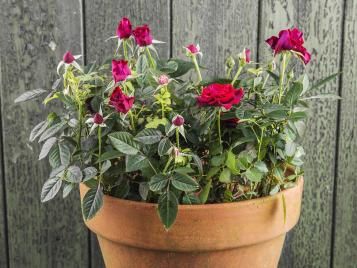
These dwarf roses can grow from 15cm to 60cm (6in to 2ft) high. They are perfect for the front of a border but are mainly grown in small containers.
Bush roses
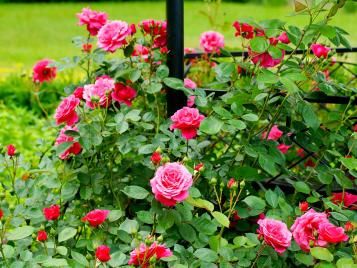
This includes hybrid tea (sometimes called large-flowered roses), floribunda (sometimes called cluster roses) and David Austin New English roses. They can grow from 90cm to 1.8ft (3 to 6ft) high. They are the main choice for borders and large containers and come in a vast array of colours, flower shape and fragrance. Bush roses are a popular choice as they have repeat flowering throughout the summer. They tend to be less prone to some disease such as black spot than older varieties.
Shrub roses
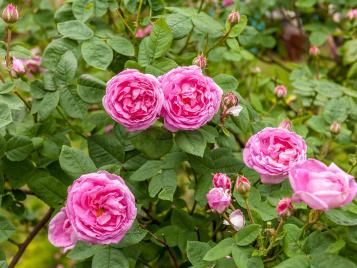
This is the term given to a broad group of roses that includes the old-fashioned varieties, such as Bourbons, Centifolias and Albas, and species roses. Shrubs can be dwarf in height or grow up to 2.4m to 2.7m (8ft to 9ft) high. Most are quite vigorous and only flower for a short period in summer, and they often are highly scented and come in many colours.
Climbers and ramblers
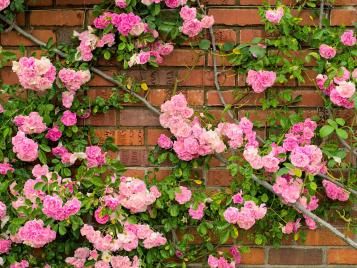
These are traditionally grown to cover walls, fences, rose arches and pergolas. The main differences between the climbers and ramblers ar that ramblers are more vigorous than climbers and only really suitable to cover large areas, they tend to only flower once in summer and usually produce clusters of smaller flowers. Climbers are less vigorous, more compact, produce larger flowers and usually flower all summer long.
Standard roses
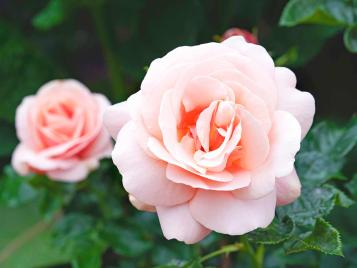
These have either a bush rose or a climbing or rambling rose (weeping standard) variety grafted on top of a single, upright stem. Standard roses are shaped to be rounded and make excellent statement or focal plants especially either side of a sunny doorway. They come in a range of heights, including quarter, half and full standards.
Ground cover roses
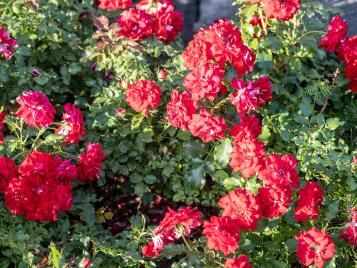
These low-growing roses are useful for covering quite large areas of ground. As they don’t produce thick mats of foliage, ground cover roses don’t tend to be that useful for weed suppression, but are brilliant for producing a carpet of colour.
Hedge roses
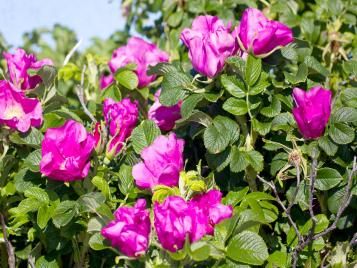
Roses such as the dog rose and rosa rugosa are perfect for hedgerows. They are wonderful for wildlife and are lower maintenance than many others. They also produce wonderful bright red hips.
Buying roses
You can buy roses in three different ways: bare-root; pre-packed; and containerised or container-grown.
Bare-rooted roses and pre-packed roses
Pre-packed roses are basically the same as bare-rooted roses, but have their roots trimmed and wrapped in plastic with a little compost. Bare-rooted roses and pre-packed roses must be planted between mid-autumn and early spring, when the plants are dormant. Soak the roots in a bucket of cool water for a couple of hours before planting, as the roots may have begun to dry out.
Containerised and container-grown roses
These can be planted at any time of year, providing that the ground is not frozen solid, waterlogged or suffering from drought conditions. Ideally plant them September to November and march to May.– Always check plants have developed a good root system before buying and planting. Always check the leaves, stems and flowers before buying and only buy strong, healthy-looking plants. This will prevent many potential problems right from the start.
Mulches are extremely valuable to help maintain favourable soil conditions, as well as reducing the level of maintenance needed, by helping to retain moisture in the soil, suppress weeds and maintain an even soil temperature.
When applying a mulch for the first time, it is best applied when the soil is warm and moist; don’t apply it to dry soil. Before applying the mulch, remove or kill any weeds, especially deep-rooted perennial weeds. Most mulching materials need to be at least 7.5-10cm (3-4in) thick to effectively control weeds and conserve soil moisture.
Generally, shrub roses, ground cover roses and standard roses need only be pruned to keep them looking tidy and within bounds, for more information read our detailed guide on how to prune roses.
Key features of roses
| Flowering season(s) | Summer, Autumn |
|---|---|
| Foliage season(s) | Spring, Summer, Autumn |
| Sunlight | Full shade, Partial shade, Full sun |
| Soil type | Clay, Loamy |
| Soil pH | Neutral |
| Soil moisture | Moist but well-drained |
| Ultimate height | Climbers up to 15m (50ft); bush varieties up to 1.8m (6ft) depending on variety |
| Ultimate spread | Up to 1.8m (6ft) |
| Time to ultimate height | 6-10 years |
FAQs
When is the best time to plant roses?
The best time to plant roses in the UK is late autumn to early spring (October to March), when the soil is moist but not waterlogged.
When should you deadhead roses?
Deadhead roses in the UK regularly during their blooming season, typically from late spring to autumn. Remove spent flowers to encourage new blooms and maintain plant health.
Do roses like ericaceous compost?
No, roses in the UK prefer neutral to slightly acidic soil, not ericaceous compost, which is highly acidic and better suited for plants like rhododendrons.

